17 Oct Review: the M.Zuiko Digital ED 50-200mm F2.8 IS PRO for Wildlife and Macro
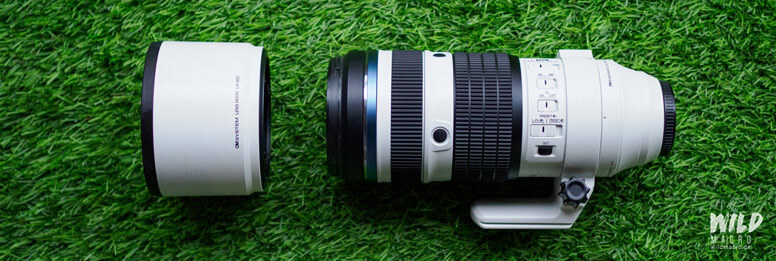
Over the past two weeks, I tested the M.Zuiko Digital ED 50-200mm F2.8 IS PRO – despite the somewhat poor German autumn weather.
Although the absolute strength of this fantastic lens is definitely its flexibility for wildlife photography across the entire focal length with a constant f/2.8 aperture, I specifically tried out the macro capabilities of the lens as well.
Paired with the MC-20 teleconverter, the 50-200mm lens not only transforms into a 100-400mm lens but also reaches 1:1 magnification, allowing for “true” macro photography.
As a macro photographer, this got me interested in particular and makes this versatile lens even more interesting.
More about this in the following lens review.
Info: As usual, in my review I focus on my personal experiences with the lens and also focus on its macro photography features.
Technical reviews and lots of sample photos can be found plenty online already.
One well-illustrated review, which I can warmly recommend, can be found on the page of OM SYSTEM Ambassador Petr Bambousek: M.Zuiko 50-200mm Review.
Over the next few weeks, I will also be adding more sample images to this review.

Quality, Handling and Features of the M.Zuiko Digital ED 50-200 F2.8 IS PRO
The little brother of “Gandalf” (a nickname going back to the aforementioned Petr Bambousek) or the “white queen,” as the M.Zuiko 150-400mm is often called, shares the same optical characteristics with the larger lens.
The white, textured finish with a thin blue ring behind the front lens looks very high-quality and makes the lens stand out from the dark range of other OM SYSTEM or Olympus lenses.


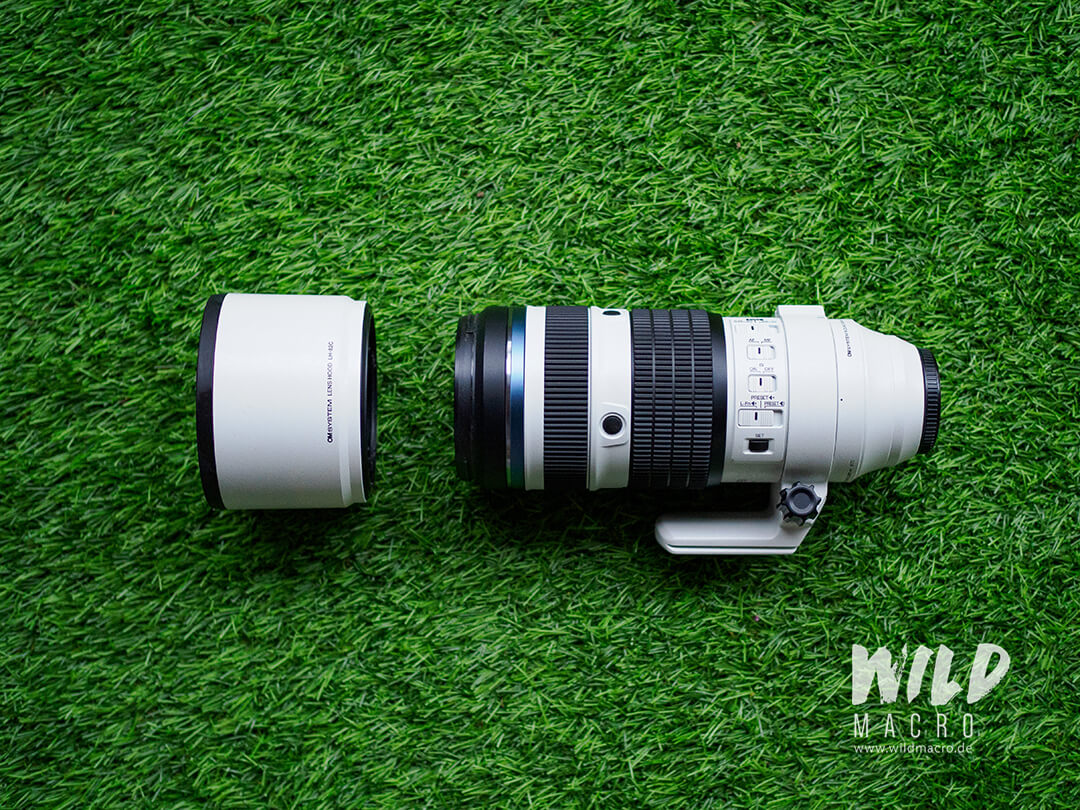
Thanks to internal focusing, the lens remains compact across the entire focal length – the barrel does not extend.
As a PRO lens, it is well balanced, excellently crafted, and IP53 weather-sealed, meaning it is resistant to water splashes, frost down to -10°C, and dust as well.
The friction of the control rings feels great: they run smoothly, and half a turn is enough to zoom from 50mm to 200mm – great!
Anyone who owns the M.Zuiko 60mm Macro knows how annoying focusing rings, that feel like you have to turn for ages, can be.
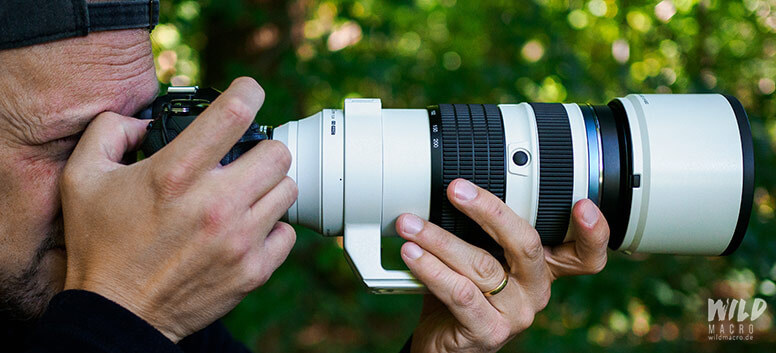
In addition to the popular, programmable L-Fn button, there are 4 more buttons arranged in a circle around the lens: here you can preset a focus distance and recall it at any time.
In combination with the camera’s custom profiles, you can store any imaginable shortcut for your personal setup, giving you more time to photograph – no more tedious menu scrolling.

With up to 50fps in C-AF mode and compatibility with Pro Capture, the 50-200mm is optimal for photographing birds and agile wildlife at close and medium distances.
Construction: 21 elements in 13 groups with 1 EDA, 2 Super-ED, 1 ED, 2 HR, and 3 E-HR elements.
Lens Coating: ZERO II coating (reduces ghosting/lens flare) & Fluorine coating (water- and dirt-repellent).


The M.Zuiko 50-200 IS PRO in the field
What immediately stands out, is the relatively low weight of the telephoto zoom.
For a focal length range of 50-200mm with a fast maximum aperture of 2.8, the white powerhouse is quite light weighing only 1kg (1.25kg with tripod collar).
In the field and on tours, it is a real advantage with guaranteed fun.
With the optional use of the MC-20 teleconverter, you have a long-reach “always-on” telephoto lens (200-800mm full-frame equivalent) with high optical quality.
For those who need even more reach, the M.Zuiko 150-400mm (+2x MC-20 option) becomes indispensable.
Of course, the sharpness at the native 400mm of the 150-400mm is crisper, than that of the 50-200mm when using the 2x converter.
However, the white goddess also costs roughly twice as much as the M.Zuiko 50-200mm, which is, of course, not inexpensive either.

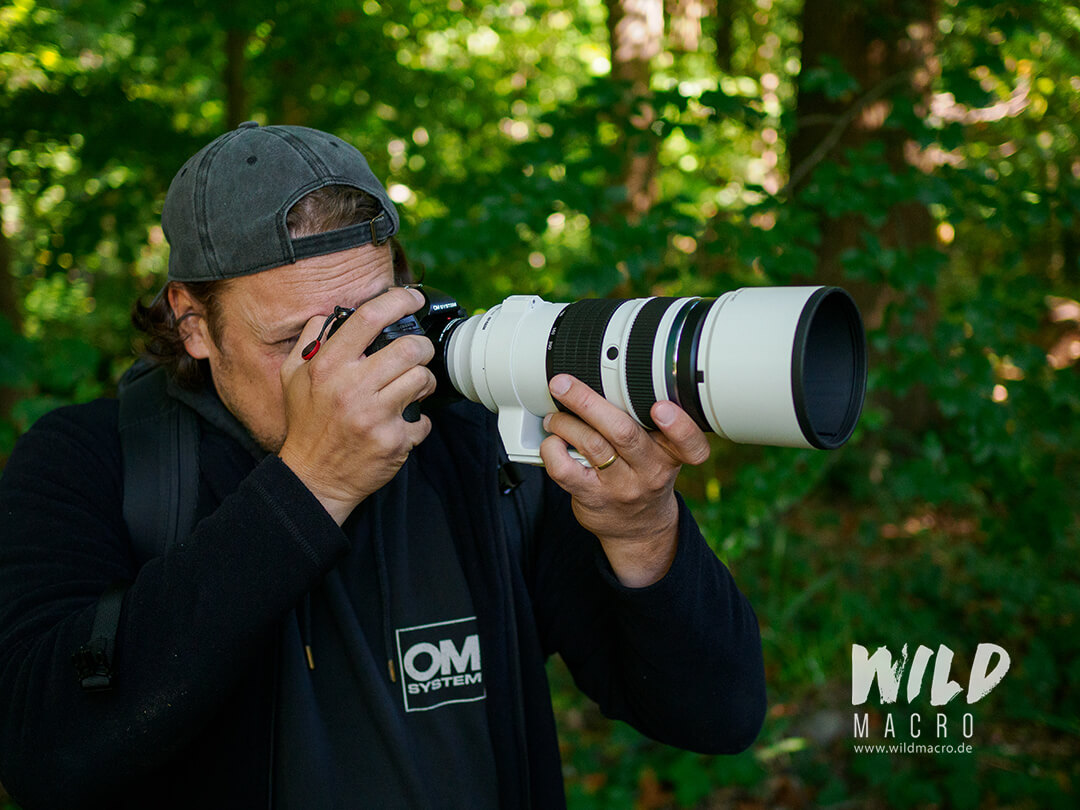
What is particularly noticeable at the long end of the focal length, is how remarkably steady the viewfinder gets, as soon as you focus: the 5-axis Sync IS compensates up to 7 stops on a suitable camera.
The advertised 1/3 second at 200mm (400mm full-frame equivalent) handheld is not some unrealistic marketing claim but indeed achievable!
Especially with long focal lengths, the outstanding image stabilization of the OM SYSTEM is clearly noticeable.
The extreme stabilization is also very helpful when filming.
If, like me, you have rather large hands, you should consider pairing such a telephoto lens with the HLD-10 battery grip—for more surface to grab and greater comfort, especially when taking vertical shots.

The macro photography capabilities of the M.Zuiko Digital ED 50-200 F2.8 IS PRO
Essential for using the 50-200mm telezoom in true macro range is the MC-20 teleconverter: with it, the lens actually achieves 1:1 magnification.
The maximum aperture is then changed to f5.6 (with the MC-14, f4.0).
The minimum focusing distance remains the same at 78cm, measured from the sensor to the subject.
This corresponds to approx. 55cm measured from the front lens element.
The quality is somewhat reduced compared to the sharpness without using the MC-20 – but in return, you get an extremely versatile tool that´s great for photographing flying insects like dragonflies and butterflies, or those that have a fairly large flight distance.
The magnification ratio of 1:2 at 200mm when not using the MC-20 is also not to be underestimated and is already sufficient for larger macro subjects – with the advantage of an aperture of f2.8.
When you hit the focus here, the lens renders a very nice background bokeh at f2.8.
Click the following example shots for an enlarged view.
EXIF: f10, 1/100sec, ISO1250, Fokus Stack from 3 images – M.Zuiko 50-200mm f2.8 IS PRO – OM-1 Mark II – MC-20 2X Tele-Converter
EXIF: f4.5, 1/80sec, ISO640, Fokus Stack from 10 images – M.Zuiko 50-200mm f2.8 IS PRO – OM-1 Mark II – MC-20 2X Tele-Converter
EXIF: f7.1, 1/40sec, ISO800, Focus Stack from 2 images- M.Zuiko 50-200mm f2.8 IS PRO – OM-1 Mark II – MC-20 2X Tele-Converter
For tiny subjects under 1 cm, you really have to rely on excellent lighting conditions for optimal results.
In direct comparison with dedicated macro lenses like the M.Zuiko 60mm or M.Zuiko 90mm, the telezoom noticeably falls behind.
But the M.Zuiko 50-200mm is neither intended nor capable of being a direct competitor, since it is a telezoom and not a macro lens.
However, it CAN capture truly good macro photos, provided the subject is suitable (particularly in terms of size) – a great bonus for a strong wildlife telephoto zoom lens – what more could you want?
Additional stabilization such as a tripod, a beanbag, or even just a railing is helpful for good macro results.
In general, macro photography greatly benefits from using a flash with a diffuser – which is naturally more challenging with the 50-200mm than with a classic macro lens.
Personally, I see the strengths of the white allrounder in photographing butterflies, bees, dragonflies, or smaller birds, for example, and not in creating extreme macro deep stacks of tiny jumping spiders, ants, or minute beetles.
Here, the 50-200mm lens has a clear advantage over pure macro lenses thanks to its comfortable minimum focusing distance.
The compression of the telephoto lens also has a beneficial effect in macro photography, creating wonderfully blurred, creamy backgrounds with beautiful bokeh.
It´s also compatible with in-camera functions such as focus stacking and focus bracketing.
The greater depth of field achieved in this way is, of course, not limited to macro photography — these functions can also be used in landscape photography.
Pros and Cons of the M.Zuiko 50-200 IS PRO
Pros:
- Fast, constant f/2.8 aperture – perfect for action shots of flying birds and fast wildlife, and when light is scarce.
- Compact and lightweight, considering the focal length coverage and brightness.
- Completely weather-sealed thanks to IP57 certification.
- Compatible with OM camera software features such as focus stacking/bracketing, Pro Capture, high-speed FPS modes, and more.
Cons:
Does the M.Zuiko 50-200mm really have any disadvantages?
I actually find it difficult to name any, because there is no other lens that covers this focal length range at f2.8 in such a compact and weather sealed design.
Of course, at the upper end a bit more focal length, say 300mm, would be ideal—but at what price?!
If maximum reach is the goal, the 150-400mm is still an option—but that costs twice as much.
The M.Zuiko Digital ED 150-600mm F5.0-6.3 IS would also be an alternative – but again, the 50-150mm focal length range would be missing.

left: M.Zuiko Digital ED 150-400mm F4.5 TC1.25X IS PRO – right: M.Zuiko Digital ED 150-600mm F5.0-6.3 IS
Update: The only minor issue for me, is the mechanism of the lens hood, which requires pressing a small button to remove it – this can be fiddly at times and is not as quick or intuitive as, for example, with the M.Zuiko 300mm IS PRO or the classic twist mechanism.
Conclusion
The M.Zuiko 50-200 F2.8 IS PRO is a really strong all-rounder: compact, fast, relatively light, with a versatile focal length and crisp sharpness!
Its build quality and design are beyond any doubt.
Anyone who has the budget and wants to cover this exact focal length can’t go wrong with this lens.
There is actually no comparable lens on the market.
Equivalent to full-frame, we have a weather-resistant, compact telephoto zoom lens with a 100-400mm focal length at f2.8 – that’s really impressive.
In my camera backpack, it will now replace my beloved M.Zuiko 300mm – I prioritize versatility in use over the extra 100mm focal length.
In terms of size, the two lenses are comparable.
Release-Deal:
If you plan on getting the M.Zuiko 50-200mm anyways, send me a short Email before buying, and I will get you a
5 years OM extended warranty (worth 149,00 Euro) for free.

The perfect combination: Tele lenses paired with the OM-1 II and a free HLD-10 battery grip

Currently, there is the Telezoom Cashback available in the OM SYSTEM online shop:
As perfect addition to the M.Zuiko 50-200mm F2.8 IS PRO, for example, you can get the OM-1 Mark II with a €300 cashback and an additional free HLD-10 battery grip.
The HLD-10 is also included for free with the OM-1 II kit with M.Zuiko 12-40mm F2.8.
You can find the complete list of all Telezoom Cashback offers, including a hefty €300 cashback on my previous favorite telephoto lens, the 300mm IS PRO, here.
| Product | Cashback |
|---|---|
| OM-1 Mark II | 300€ Cashback + HLD-10 Battery Grip |
| OM-1 Mark II + 12-40mm II Kit | 300€ Cashback + HLD-10 Battery Grip |
| OM-5 Mark II (black, silver, sand beige) | 200€ Cashback |
| OM-5 Mark II (black, silver) + 12-45mm Kit | 200€ Cashback |
| OM-5 Mark II (black, silver) + 14-150mm II Kit | 200€ Cashback |
| OM-5 Mark II (black, silver) + 12-40mm II Kit | 200€ Cashback |
| 150-600mm | 600€ Cashback |
| 300mm | 300€ Cashback |
| 40-150mm f2.8 | 200€ Cashback |
| 100-400mm II | 200€ Cashback |
| 40-150mm f4 | 200€ Cashback |
The offer is valid till 29.10.2025 – Cashback can be redeemed till 12.11.2025.
Click here, to get to the Telezoom-Deal in the OM SYSTEM Onlineshop directly.

To top this even more, there´s a limited Autumn Super Deal from 15.-20.10.2025 with up to 50% OFF, with the MC-14 tele-converter, the EE-1 Red-Dot sight, or the100-400mm.
Find all participating products here.
Use the Code AUTUMN2025EURO during checkout.
Win a safari trip to Namibia!

Each purchase of a M.Zuiko 50-200mm F2.8 IS PRO or M.Zuiko 150-400mm F4.5 IS PRO entitles you to participate in a raffle to win a safari for 2 people in Namibia.
Purchase and registration for the raffle have to be finalized until 15th of January 2026 (last day of taking part in the raffle).
Travel dates: 30. April – 7. May 2026
Departure: from Germany
Register here for the raffle to win your Namibia Safari.
Good luck!
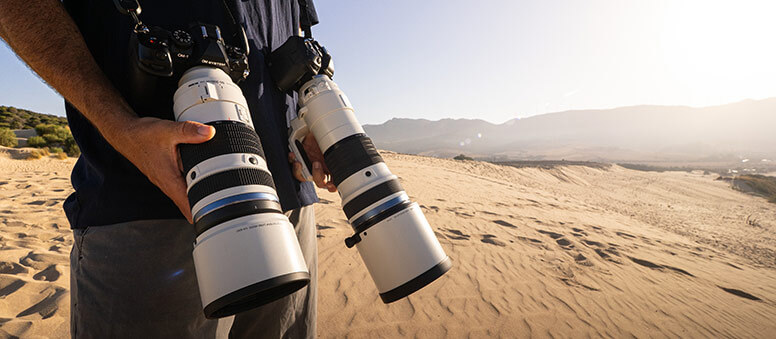
Sign up for the newsletter mailing list & free ebook

Did you enjoy these tips and want to learn more or improve your macro photography skills?
Stay up to date with new blog posts, reviews and tutorial- and ebook-releases.
Sign up below to get notified when the free edition of my ebook
‘How to master spider & insect macro photography’ is ready for download.






Alex
Posted at 14:28h, 16 NovemberThank you for the useful review!
“Equivalent to full-frame, we have a weather-resistant, compact telephoto zoom lens with a 100-400mm focal length at f2.8”
It’s actually f`5.6: the physical aperture is 71mm, and 400mm/71 = 5.6.
wildmacro-chris
Posted at 15:07h, 16 NovemberYes, that wasn´t expressed properly – thanks for the clarification.
There is a super interesting video on YT comparing the actual aperture “looks” between various lenses.